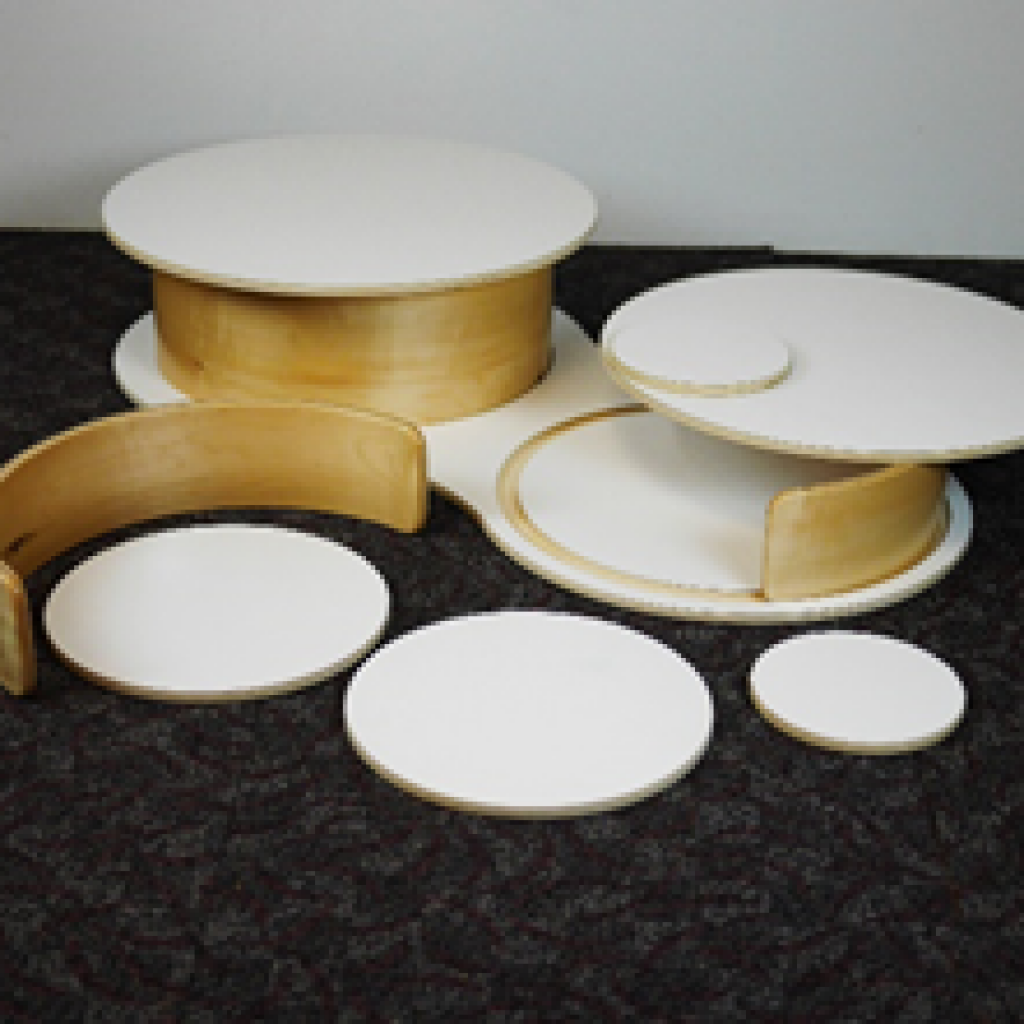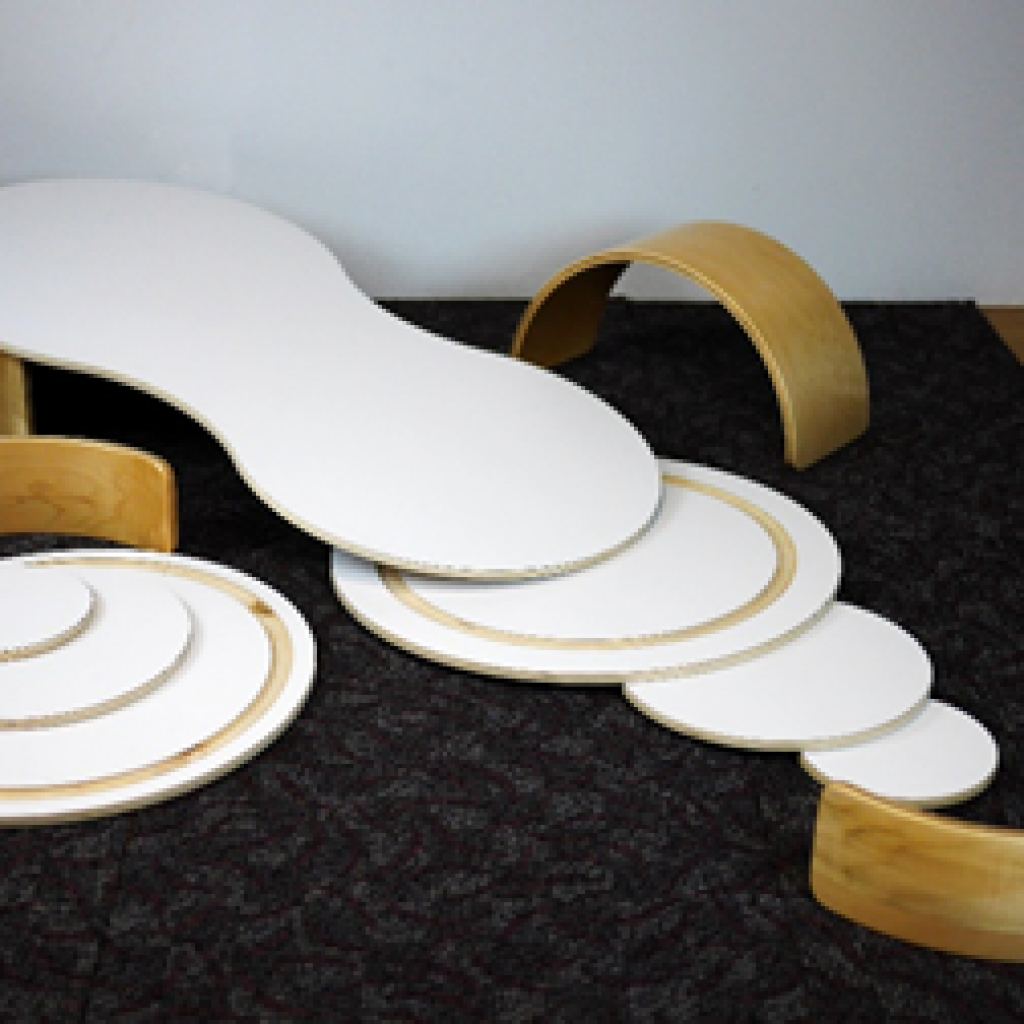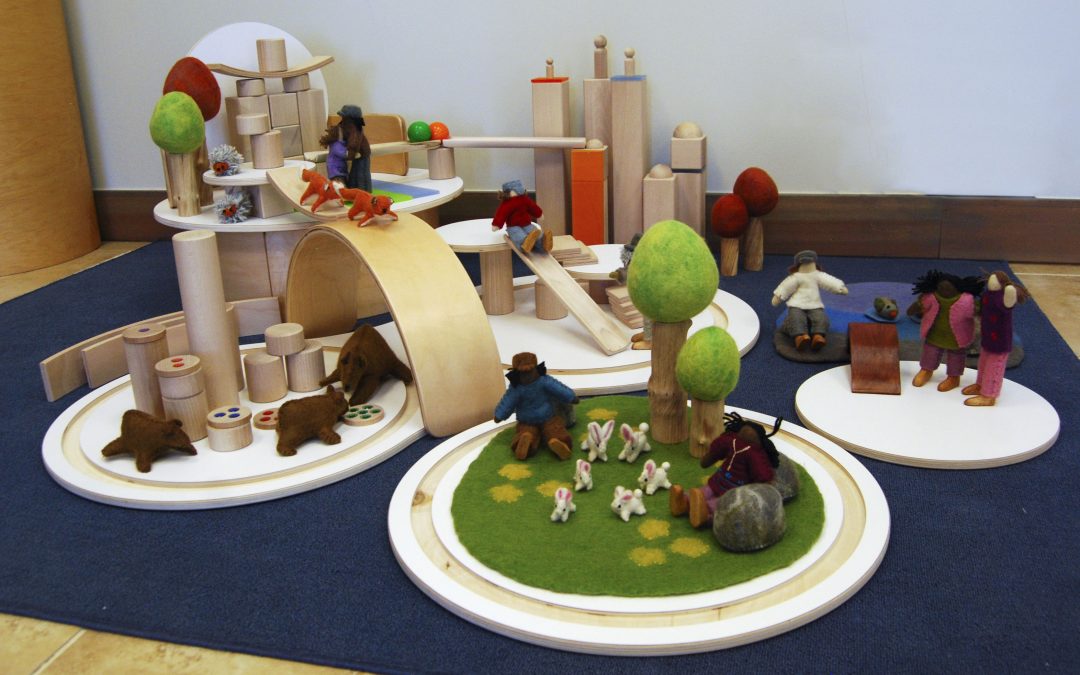Imaginative social play occurs in many places within the classroom. We love to encourage social play everywhere both indoors and out! With this project however, we wanted to create a focused space that supports a child’s imagination as they build worlds and landscapes. We focused on flexibility and providing options so the play environment would follow the child’s play. The idea that materials should follow childrens play vs dictating their play was fundamental in our design. So much of a child’s world is determined for them especially their environment.
With the Playscape Platforms we looked to change this by providing “ground planes” that are arranged by the child. Instead of just building on a single plane of a floor or table, these platforms can be elevated and arranged to create dynamic worlds leading to more complex and involved play. We chose elegant organic shapes as the design language so there would be no front or back, but instead equally approachable from all sides. This encourages community, enhancing social play. The white laminate was an intentional choice to downplay the pieces and create a “generic” foundation upon which children will build their story. Combine with everyday classroom materials like blocks and characters the play possibilities are endless. The Playscape Platforms are intended to serve children in their play and from what has been observed in many classrooms, we have succeeded!
As with many Kodo materials, there are multiple ways in which to use the Playscapes Platforms. Just view the photos to see it put together in multiple ways:





Integrating STEM and 21st Century Skills
21st Century Skills
- CREATIVITY: Children develop play scripts, engage in imaginative role-play, and use materials to create characters and settings.
- COMMUNICATION
- Expressive Language
- Receptive Language
- Vocabulary
- CRITICAL THINKING: Children assign meaning and purpose to block play materials. Problem-solving opportunities arise as structures and story settings are built.
- COLLABORATION: Incorporating other’s ideas and negotiating roles and actions encourages collaboration.
Integrated STEM Concepts
- SCIENCE
- Material Properties
- Balance
- Cause and Effect
- TECHNOLOGY: Children use low-tech tools during construction play such as blocks and builders, writing tools, and drawing materials.
- ENGINEERING: Building and constructing with blocks and loose parts invites exploration of balance, structure, and stability.
- MATH
- Spatial Relationships
- Geometry
- One-to-One Correspondence
In this interaction, the Playscapes Platform became a musical instrument!
Connecting to the Standards
So, what’s the big deal? Yes, it’s a beautiful material to have in the environment, but why is this important to children’s learning? One might think this is an unnecessary accessory to have in the environment, but at Kodo, we see the numerous curriculum possibilities and believe it should be a staple material that supports learning. The ability to expand not only children’s thinking and problem-solving within the block area, but the ability to connect to storytelling, dramatic play, social and emotional development, and even physical development! Imagine one tool or resource in the classroom that fosters the whole child?!
Teaching Strategies Objectives
Social and Emotional
- Establishes and sustains positive relationships
- Participates cooperatively and constructively
Physical
- Demonstrates gross-motor manipulative skills
- Demonstrates fine-motor strength and coordination
Language
- Uses language to express thoughts and needs
- Uses appropriate conversational and other communication skills
Cognitive
- Demonstrates positive approaches to learning
- Remembers and connects experiences
Uses classification skills
- Uses symbols and images to represent something not present
Literacy
- Comprehends and responds to books and other texts
- Mathematics
- Explores and describes spatial relationships and shapes
- Demonstrates knowledge of patterns
Science and Technology
- Uses scientific inquiry skills
- Uses tools and other technology to perform tasks
Social Studies
- Demonstrates knowledge about self
The Arts
- Explores drama through actions and language
Head Start Alignment
Approaches to Learning – Cognitive Self-Regulation
- Goal P-ATL 6. Child maintains focus and sustains attention with minimal adult support.
- Goal P-ATL 7. Child persists in tasks.
- Goal P-ATL 8. Child holds information in mind and manipulates it to perform tasks.
- Goal P-ATL 9. Child demonstrates flexibility in thinking and behavior.
Approaches to Learning – Initiative and Curiosity
- Goal P-ATL 10. Child demonstrates initiative and independence.
- Goal P-ATL 11. Child shows interest in and curiosity about the world around them.
Approaches to Learning – Creativity
- Goal P-ATL 12. Child expresses creativity in thinking and communication.
- Goal P-ATL 13. Child uses imagination in play and interactions with others.
Social and Emotional Development – Relationships with Adults and Other Children
- Goal P-SE 1. Child engages in and maintains positive relationships and interactions with adults.
- Goal P-SE 2. Child engages in prosocial and cooperative behavior with adults.
- Goal P-SE 3. Child engages in and maintains positive interactions and relationships with other children.
- Goal P-SE 4. Child engages in cooperative play with other children.
Language and Communication – Vocabulary
- Goal P-LC 6. Child understands and uses a wide variety of words for a variety of purposes.
- Language and Communication – Comprehension and Text Structure
- Goal P-LIT 4. Child demonstrates an understanding of narrative structure through storytelling/re-telling.
Mathematics – Geometry and Spatial Sense
- Goal P-MATH 10. Child explores the positions of objects in space.
- Scientific Reasoning – Reasoning and Problem Solving
- Goal P-SCI 6. Child analyzes results, draws conclusions, and communicates results.
- Perceptual, Motor, and Physical Development – Gross Motor
- Goal P-PMP 1. Child demonstrates control, strength, and coordination of large muscles.
Perceptual, Motor, and Physical Development – Fine Motor
- Goal P-PMP 3. Child demonstrates increasing control, strength, and coordination of small muscles.
Follow Along
Do you follow us on Social Media? In the month of December 2019, Kodo will be taking a closer look at the Wind Tunnel and the materials, tools, and accessories to enhance the play and learning for children. Follow along using #kodoplayscapesplatform



Encourage social play. Collaboration, expand thoughts with materials